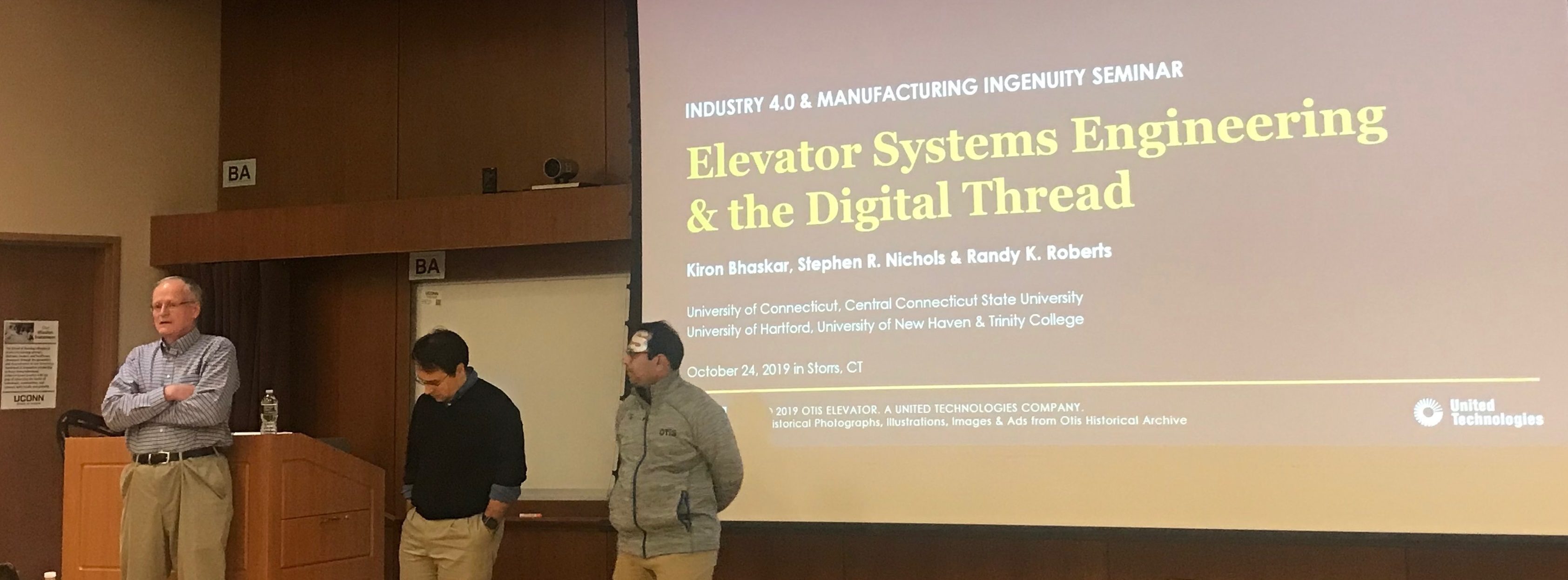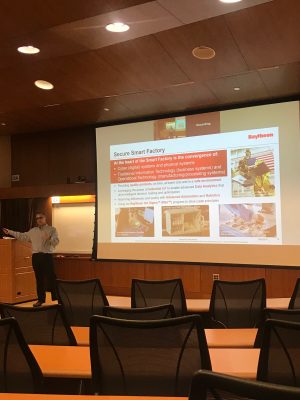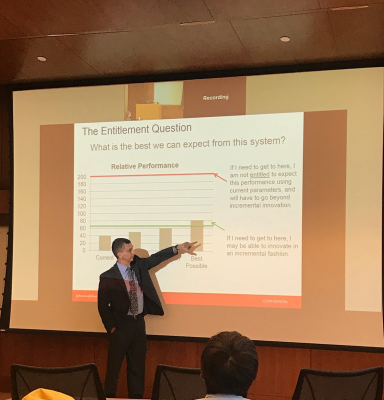
On October 24th, Mr. Kiron Bhaskar, Mr. Stephen R. Nichols, and Dr. Randy K. Roberts spoke at the Industry 4.0 and Manufacturing Ingenuity course. The course, funded by CTNext, fosters innovation and entrepreneurship by providing students with exposure to emerging technologies in automation and AI, IoT, big data, cyber physical systems, and smart manufacturing. The course is built upon seminars by invited industrial speakers to introduce cutting-edge technologies and challenges.
Dr. Roberts held a position at UTRC before moving to OTIS 23 years ago. He now works in the systems engineering area and has a background in physics-based modeling. Mr. Nichols grew up in Connecticut and was on a FIRST Robotics team before working at OTIS. He earned his degree in Mechanical Engineering, interned at OTIS, was hired with a full-time position at OTIS, and attended graduate school, supported by OTIS. His interests include innovation, program management, finance (in which he worked for two years), and systems engineering. Mr. Nichols previously led the technology group responsible for passenger experience and is now focused more broadly on systems engineering and connected systems topics. He has worked with OTIS for 13 years. In India, Mr. Bhaskar was involved in the oil & gas industry doing hands-on mechanical engineering work. He has been in the Systems Engineering group with OTIS for 11 years.
In the talk entitled “Elevator Systems Engineering & the Digital Thread”, Mr. Bhaskar stated that with elevators, OTIS is always earning money throughout the life cycle of the product, so it is a profitable and stable business. Some challenges facing the elevator industry include: the ability to stop the elevator car when it is going too fast, complex buildings are making it harder to install elevators, tall buildings are difficult and challenging as well. Mr. Bhaskar also discussed that it is important for OTIS to follow trends in industry, which include connectivity, passenger experience, predictive maintenance, smart dispatching, robotic interfaces, facial recognition, and understanding passenger locations in the building. OTIS ONE is a new IoT platform with transparent, proactive & predictive tools. Advanced monitoring through smart sensors is transferred to the cloud so that the mechanic can understand the problem and solve it faster.
Mr. Nichols discussed the Digital Thread. “Reducing risk is a theme that OTIS is trying to keep. Reduce risk as you go.” He explained that model-based engineering is faster and cheaper than conventional engineering. “You can do more virtually than you can ever do physically”. To do this, one should use leverage models and data across the product life cycle. There should be a model to predict, and data to learn and verify. Then one can obtain continuous integration using models and leverage surrogate models for fast analysis. Then use minimum viable product (MVP) to activate the learning loop quickly. The learning loop is a model where one reacts, observes, learns and predicts. It is the loop between the model and data from an operation, allowing one to gain insight, learn, optimize, & customize.
Dr. Roberts spoke about model-based design applications. SysML is a language that is used to implement model-based systems engineering (MBSE). At the very beginning of a project, SysML allows one to connect together the parameters of requirements, parametrics, behavior and structure. You can put this into a flexible, relational SSOT (single source of truth) database that forms the basis for the digital thread. This is a form of MBSE, the use of modeling to support system requirements, design, analysis, verification, and validation activities beginning in the conceptual design phase and continuing throughout the product life cycle.
Mr. Bhaskar, Mr. Nichols, and Dr. Roberts closed by discussing how students could apply for summer internships at OTIS and encouraged students to apply for engineering and manufacturing jobs at OTIS by visiting the careers page of www.otis.com.

